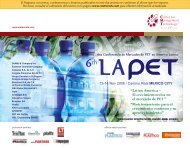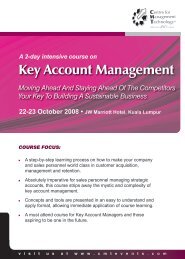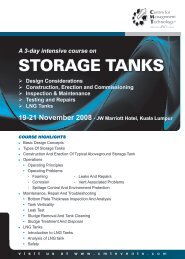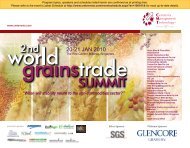PDF Brochure - CMT Conferences
PDF Brochure - CMT Conferences
PDF Brochure - CMT Conferences
Create successful ePaper yourself
Turn your PDF publications into a flip-book with our unique Google optimized e-Paper software.
INTRODUCTIONChange happens all the time, whether we chooseto do something about it or do nothing. Changesoccur in a plethora of arenas including: technology,competitive environment, political, economic, society,technology, legal, environment, and business, amongothers. Some changes occur in gradual fashion,and we may not even notice it creeping up on us.Other changes occur in quantum leaps, such as intechnology (witness Moore’s Law). Unless we areaware of the changes taking place around us, we runthe risk of being left behind and playing catch-up orworse still, becoming irrelevant.An important element in our desire to remain relevantand ahead of the ‘pack’ will be the need to have acurrent analysis and “future focus.” The one to providea reality check and the other for looking forward,spotting emerging and waning trends, identifyingtrigger or inflection points, creating strategies andimplementing them. The use of various managementanalysis and other tools will assist towards this aim.With this in mind, this workshop is designed toprovide a structure against which the group would beable to rate their change quotient in terms of changereadiness, create a scenario of change and its impacton the organization, acquire and practice appropriateskills while developing and implementing strategiesto enable them to anticipate and be prepared to seizethe opportunities that present themselves our way.“Action leads us toward solutions. Inaction atbest does nothing and holds us in the past”.THE APPROACHThis will be a highly participative and interactive andhands-on workshop where learning new approachesand sharpening skills is mainly by action learningthrough exercises and workshops. This will besupplemented by appropriate lecture/discussion, andvideos as applicable.The frequent use of reflection at the end of each majoractivity will help enhance understanding and measureparticipant’s learning. Participants will find that theybenefit from the workshop in direct proportion to theirinvolvement.Day 1Wednesday, 17 December 2008Module 1STRATEGIC THINKING DEFINED• Introductions• Definition of Strategic Thinking• Strategic Thinking process• Why Strategic Thinking?Module 2DETERMINING THE DIRECTION• Operating Vision clarification• Core Value Drivers driving the Vision• Stakeholder ExpectationsModule 3WHO ARE WE? THE FIRST STEP• Identifying our purpose• Creative Expressions• Change Readiness InventoryModule 4PEERING THROUGH THE FOG & CLOUDS• Scenario Analysis – best case, worstcase, most likely• Trends Analysis – boundary,emerging, established, dying• Mining the available resource –bottom-up approachMETHODOLOGY• Use of presentations to set up the context• Exercises to enable participants to apply theirlearnings• Left & Right Brain activities to enable wholebrainlearning• Video presentations as a learning tool• Brainstorms to generate ideas and involveparticipation
















